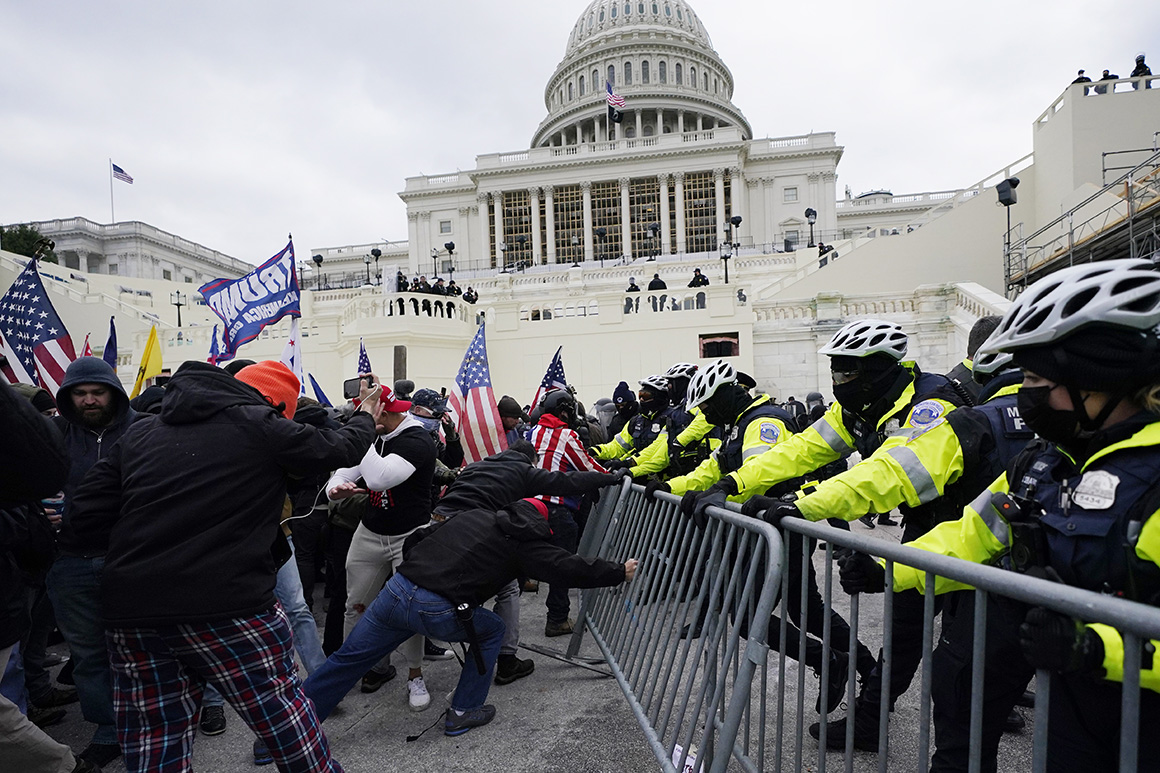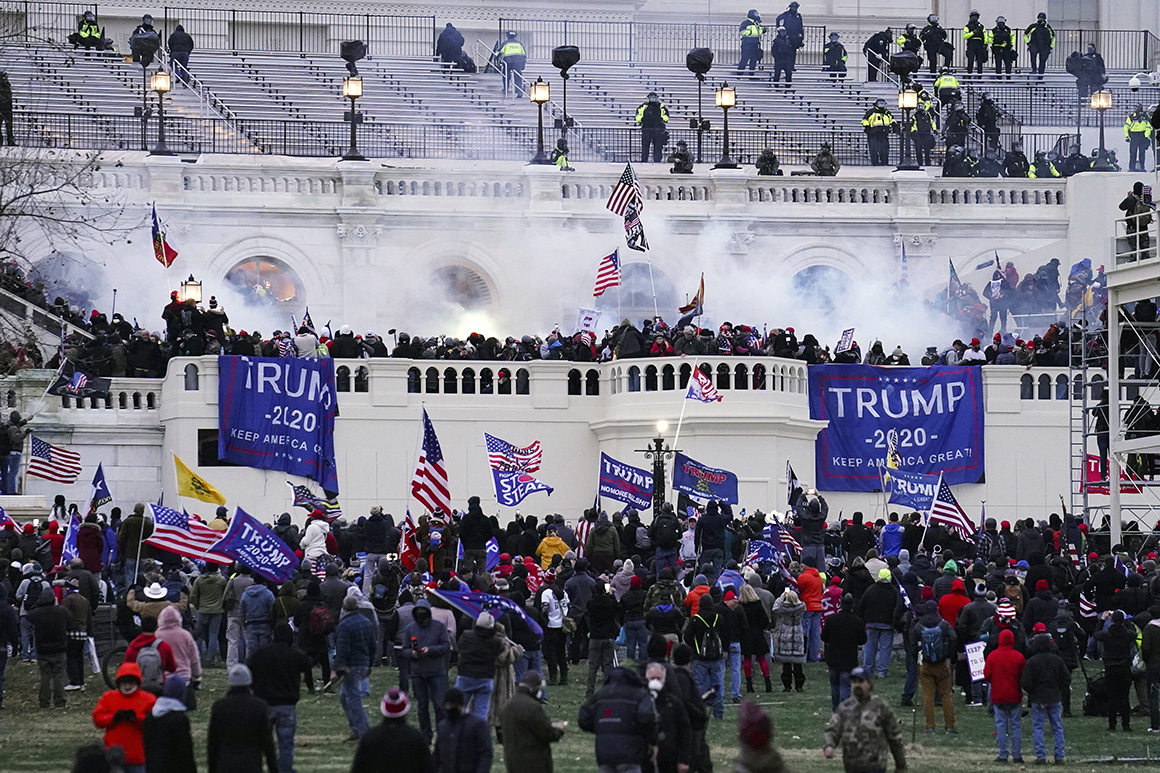
The day before the Jan. 6 riot, an internal U.S. Capitol Police document warned officers to be ready for potential attacks on police lines and the inaugural platform. But the preparation wasn’t nearly enough.
According to a previously unpublished internal memo reviewed by POLITICO, the police made plans for plainclothes officers to monitor protesters — a widespread but controversial tactic that appeared to do little to stave off the violence that day.
The document opens with what now seems like a deeply misguided threat analysis: “At this time there are no specific known threats related to the Joint Session of Congress Electoral College Vote Certification,” it reads.
POLITICO reviewed “The Civil Disturbance Unit Operational Plan,” a 17-page strategy document for police on the day of the Electoral College certification. It sheds new light on how Capitol Police geared up for the protests, detailing the force’s concerns about counterprotesters, which turned out to be unwarranted. And it shows that in some ways, the department was prescient about the violence that would unfold, but didn’t deploy enough defenses to counter the riots.
One of five mission objectives the document lists was to “[e]stablish and maintain a fixed march route while excluding access to counter-protestors to minimize potential for violent interactions.” That objective quickly dissolved as protesters overran police barricades and stormed the Capitol.
Later, the document details further plans for dealing with anti-Trump protesters. “[C]ounter-protestors will be expected to attempt to gain access by entering shrubbery and other natural fixtures,” it reads. The memo also said “it is anticipated that a march will likely progress into the Capitol Grounds,” and that Washington’s Metropolitan Police Department would escort the marchers. Then as the marchers neared the Capitol, USCP Civil Disturbance Unit platoons “will move with the marchers” and block counterprotesters from entering the march’s route and destination west of the Capitol building.
But every step of the way, these strategies laid out on Jan. 5 were blown up on Jan. 6.
“As the Department has said publicly time and time again — we knew some people were planning violence,” a Capitol Police spokesperson told POLITICO. “No law enforcement or intelligence agency predicted the large-scale attack that ended up happening. Typically, and this is documented in decades of USCP working protests on the Hill, violence occurs between protesters and counterprotesters. That was NOT the only thing our officers were told to focus on. Every year our officers train for many different threat scenarios.”
None of five “mission objectives” came to fruition: “1. To provide an environment in which lawful first amendment activity can be safely demonstrated. 2. To prevent any adverse impact to the legislative process associated with unlawful demonstration activity. 3. To effectively mitigate actions associated with civil disorder; safely respond to crimes of violence and destruction/defacing of property. 4. To safeguard and prevent any property damage directed at the US Capitol, West Front Inaugural Platform, and all Congressional buildings. 5. Establish and maintain a fixed march route while excluding access to counter-protestors to minimize potential for violent interactions.”
The Capitol Police department has faced criticism for overemphasizing the threat from counterprotesters and underestimating the danger that many of former President Donald Trump’s supporters posed. One high-ranking official, Deputy Chief Eric Waldow, radioed at 8:24 a.m. on Jan. 6 that officers needed to look for “any anti-Trump counter protesters,” as POLITICO previously detailed. The Civil Disturbance Unit document notes that he was Incident Commander that day.
A whistleblower report also detailed Waldow’s fight against protesters that day. “He never left the fight...never,” the whistleblower wrote. “He was literally unrecognizable from the burns to his swollen face.”
But senior Capitol Police officials have said that engagement in those fights might have contributed to the chaos. “They started to participate and assist the officers with boots on the ground versus providing that guidance and direction, if you will,” then-acting Capitol Police Chief Yogananda Pittman testified to Congress in February.
The document also shows that in some ways, Capitol Police planned to combat the exact type of violence that happened on Jan. 6 — just with woeful inadequacy.
Officers with less-than-lethal weapons were stationed to disperse crowds in case “an attempted breach of the East and West Front restricted area poses an immediate risk to officers on the police line and the demonstrated potential for violence and damage to property; in particular the Inaugural Platform,” the document reads. In that way, the document predicted exactly what attackers did. Some of the most jarring photos from that day show Trump supporters swarming over the inaugural platform.

The Capitol Police also deployed plainclothes officers to track protesters. That practice, which police departments across the country have used, faces steep criticism for potentially frightening people off from exercising their First Amendment rights to speak and assemble.
“Intelligence note; numerous social media posts include promoting attending protest activity armed,” it read. “CS teams will be monitoring for participants open carry and potentially concealed.” In this context, CS stands for countersurveillance — officers who don’t wear uniforms and sometimes monitor protesters on the ground to gather intelligence on their activities.
Later, the report added more detail.
“Plainclothes officers will be operations and will be serving in an intelligence collection capacity,” it reads. “Plainclothes officers may also alert USCP communications of observed criminal activity requiring uniformed officers to initiate stops/contacts/preliminary investigations/arrests.”
It is unclear how much intelligence plainclothes officers gathered that day. One officer who fought protesters outside the building told POLITICO that he was not aware of any warnings from plainclothes officers before attackers first swarmed police barricades.
“Our counter surveillance teams are not undercover,” the Capitol Police spokesperson said in a statement. “What we mean by that is that they do not act as protesters in the crowd. Nor do they infiltrate the crowd. They dress in plain clothes and post up around the city to monitor the crowd. That information is passed onto supervisors.”
The spokesperson added that a countersurveillance team found one of two pipe bombs planted that day.
The presence of law enforcement officers and assets in protests has long generated controversy. Many on the right have cited the presence of an FBI informant at the Capitol riot to insinuate without evidence that law enforcement incited the attack. But the practice has historically drawn much more criticism from progressives.
The Texas Department of Public Safety confirmed in June 2020 that it embedded plainclothes officers in protests against the murder of George Floyd by a Minneapolis police officer. And in June of that same year, the New York Police Department shut down plainclothes teams in the wake of citizens’ complaints about their practices, as well as teams’ connection to police shootings. Eric Adams, New York’s likely next mayor, has signaled he will bring back the plainclothes teams in some form.
Sahil Singhvi argued last summer in a column for the Brennan Center for Justice that police infiltration of anti-police-brutality protests chilled free speech.
“[T]he history of police infiltration is one of the government disproportionately targeting progressive activists and movements — sometimes even going so far as to gin up violence as justification for scrutiny — rather than keeping protesters safe,” Singhvi wrote.
One former FBI agent told POLITICO any plainclothes officers would likely have been of limited effectiveness.
“Obviously, no one needed a spotter in the crowd to know that the Capitol was coming under assault, even if they hadn’t seen all the public warnings,” said Michael German, a fellow with the Brennan Center for Justice’s Liberty & National Security Program and a former FBI special agent. “If this planned placement of plainclothes officers in the crowd actually took place on January 6th, obviously they were not able to provide timely intelligence to prepare an effective defense of the Capitol.”
But Paul Butler, a law professor at Georgetown and a former federal prosecutor, said that since no protesters had a permit to enter the Capitol on Jan. 6, “to the extent that there were plainclothes officers who were with the protestors, it certainly would be valuable to have intelligence from among the protesters who were plotting violence and other illegal acts.”
Dozens of officers were seriously injured on Jan. 6, and one Capitol Police officer died in the days after the insurrection. Several Capitol Police and Metropolitan Police Department officers who responded on Jan. 6 have also since died by suicide.
Since Jan. 6, the U.S. Capitol Police has implemented a raft of measures to improve security at the Capitol, including overhauling its major event planning processes and improving the way it handles intelligence. It has increased intelligence sharing with law enforcement partners and beefed up its partnership with the intelligence community. The Capitol Police have also bought more helmets, shields, batons and less-than-lethal munitions and used a Defense Department loan to get more surveillance technology to detect threats.
----------------------------------------
By: Betsy Woodruff Swan and Daniel Lippman
Title: New Capitol Police document shows how unprepared they were for Jan. 6 riots
Sourced From: www.politico.com/news/2021/10/29/capitol-police-documents-unprepared-jan-6-riots-517478
Published Date: Fri, 29 Oct 2021 04:01:50 EST
Did you miss our previous article...
https://consumernewsnetwork.com/politics-us/new-congressional-map-illinois-dems-create-liberal-giantslayers-district






